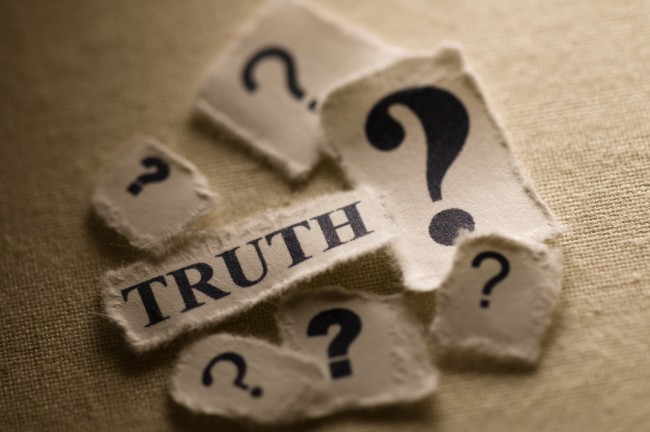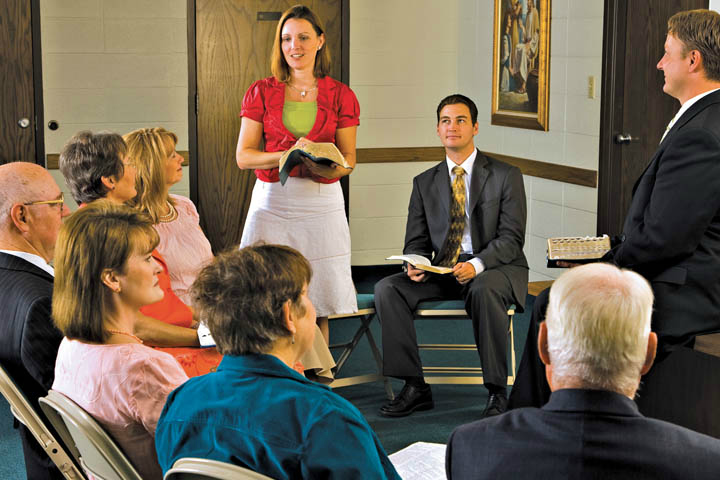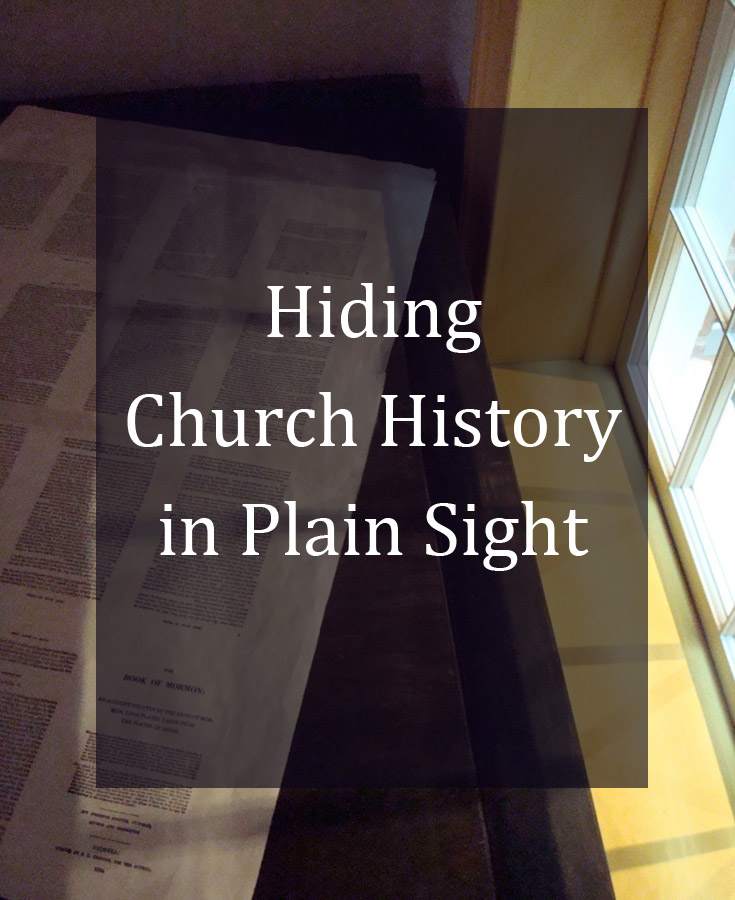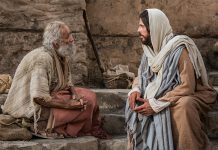
Unsettling Discoveries
A few days ago, I received an email from a friend (we’ll call him John) explaining that his brother (we’ll call him Bill) was quitting the Church. Why? Bill feels he’s been lied to by present and past prophets. Apparently, Bill discovered what he thought was disturbing information about the manner in which Joseph Smith translated the Book of Mormon.
The information changed the way Bill viewed the prophet—it made Joseph Smith seem like either a gullible magic-influenced hick or a clever conman. Either way, the information wasn’t very complimentary to a man who is revered as a Prophet of God.
To make matters worse, Bill discovered that defenders of the Church didn’t deny that Joseph used “magical” tools from his environment to translate the Book of Mormon. Why, Bill wondered, had he never learned—in over 40 years of attending church—that Joseph used a seer stone to translate the Book of Mormon?
In all his years of Primary, Sunday School, seminary, institute, and priesthood meetings, he had never once heard of such a thing. He had always been taught that the plates were translated by way of the Urim and Thummin—he even saw artwork depicting the translating process in the Ensign. But that’s not what happened. And even the Church now admits as much. He had been lied to!

An Issue of Trust
When we hear the word “infidelity,” most of us probably think of adultery. The word infidelity, however, has a broader meaning. It comes from a Latin word that means unfaithfulness as well as faithlessness and is the source for the word “infidels”—which in past times referred to unbelievers as well as someone who could not be trusted. In modern times, the word “infidelity” often refers to broken marriage covenants, but also refers to other acts of disloyalty when trust is broken.
Infidelity in any relationship brings out feelings of hurt and betrayal, and the more committed we are to the relationship, the more painful the feelings. Committed Latter-day Saints are not just in a relationship with Christ, but are also in a relationship with the Church by way of local leaders and General Authorities—both past and present.
If we feel betrayed by prophets—if they’ve lied to us—we will naturally feel hurt and angry. Unfortunately, those feelings create barriers to reconciliation. If you discovered what seemed to be overwhelming evidence that your spouse had cheated on you, it becomes difficult to consider any denials, explanations, or other evidences that may relieve your pain. Every resolution offered by your spouse will be viewed with skepticism and suspicion.
Marital infidelity need not even be the result of an affair. Infidelity in a marriage can be caused by anything that makes you distrust your spouse. If you think that your spouse has been lying to you, especially on important issues (money, achievements, childcare, education, etc.), your marriage will take a hit—perhaps a fatal hit. Who wants to stay in a relationship where there is no trust?
Bill’s story is repeated frequently in the Church these days. Sometimes it’s the discovery of Joseph’s use of a seer stone, other times it’s the discovery that Joseph practiced plural marriage, and other times it’s the discovery that early leaders—including Joseph Smith and Brigham Young—had very human weaknesses, opinions, and ideas. If we discover that a prophet didn’t act in a way that we think a prophet should act, we may lose trust in that prophet and feel that the Church has lied to us by hiding those facts.

The Trickery of Hurt
As noted above, feelings of betrayal are powerfully painful and might make reconciliation impossible or, at the very least, difficult. It’s hard to regain trust. In my nearly two decades of helping people who have had their testimony challenged by “intellectual” hurdles (in other words, they didn’t lose their testimony because they found the LDS lifestyle too difficult to live or stopped believing in God because their son got cancer). I have found that the feeling of Church betrayal becomes the motivating reason to leave the Church rather than the hurdle that initially shook their faith.
In Bill’s example above, for instance, it is likely that Bill will be unwilling to seriously examine the arguments which demonstrate that Joseph Smith could still be revered as a prophet in light of the fact that he used a seer stone to translate the Book of Mormon. For the member who feels they have been lied to, when they realize that Joseph practiced plural marriage, they are less likely to listen to arguments that demonstrate that a number of Joseph’s marriages were likely dynastic (they didn’t involve intimacy) and that the Lord had some very good reasons to reinstitute plural marriage as in the days of old.

Answers are Available
The fact is, there are logical evidence-supported arguments which answer virtually every anti-LDS claim—arguments which address the meat of the issues but also show that challenging issues can be reasonably understood in a worldview that accepts the prophetic calling of Joseph Smith and the Church he was instrumental in restoring. FairMormon.org, for example—a volunteer organization of which I am part—produces articles, a wiki, podcasts, a conference, and videos that respond to difficult issues.
FairMormon has even published my book addressing these issues: Shaken Faith Syndrome: Strengthening One’s Testimony in the Face of Criticism and Doubt. Not only are there solid arguments which answer the claims of critics, but there are a multitude of evidences which support the belief that Joseph Smith was a prophet and that the Book of Mormon text is based on an authentic ancient American document (some of these evidences are briefly discussed in my Of Faith and Reason: 80 Evidences Supporting the Prophet Joseph Smith).
The problem, however, is that these pro-LDS arguments and evidences are often treated as moot nonsense by those who are pained by feelings of infidelity. Shoot down one argument and they’ll simply find another to put in its place. Once the pain of “being lied to” shifts a member’s worldview from believer to hurt non-believer, the capacity to push aside the painful feelings and listen to the arguments is severely diminished.

Inoculation
This is one of those perfect examples where an ounce of prevention is worth a pound of cure. If we can learn more about the early church and its leaders from within a faithful framework, it’s less likely to cause testimony damage. In recent months, we’ve seen the Church—by way of ChurchofJesusChrist.org—take a proactive approach to discussing topics such as plural marriage, Joseph’s seer stone, the First Vision, and the translation of the Book of Abraham.
These preventative measures are not unlike medical inoculations or vaccinations. By teaching members about potentially challenging issues from within a faithful context, most members will strengthen their testimonies, enabling them to withstand the interpretations presented by hostile sources.
Some may ask, however, “Why is inoculation necessary nearly two hundred years after the Church was restored? Why are we just now being confronted with these stumbling blocks? Why didn’t we know about the challenging issues before? Were we really being lied to?”
The answer: “No, we have not been lied to.” The reason that many members have been unaware of some of these topics is complicated, but I hope to shed some light on it. I see at least three contributing factors to the problem: 1) De-emphasis, 2) Alternative Focus, and 3) General Ignorance.

In Our Weakness
In my opinion, the single most profound scripture which helps us understand how God communicates with his children is found in D&C 1:24:
“Behold, I am God and have spoken it; these commandments are of me, and were given unto my servants in their weakness, after the manner of their language, that they might come to understanding.”
We mortals are unable to fully comprehend the things of God. Part of our human condition is the unavoidable fact that we—all of us—are weak physically, spiritually, emotionally, and even mentally. Our worldviews are weak and formed by our circumstances and environment. We have biases, misunderstandings, and false assumptions.
No human language is able to fully communicate our ideas with complete clarity. Recall the many times you couldn’t think of the right words to express your ideas or how often someone has misunderstood you—especially in an email or a text.
Despite our many weaknesses, the Lord nevertheless knows how to communicate with us—using our language, our words, our worldviews, so that He can work in us and through us and lead us to becoming more like Him. Like a parent communicating with a toddler, the Lord speaks to us in our language using terminology and metaphors which we understand. As we (individually and collectively) mature, our language matures as well and we put aside our childish language.

De-Emphasizing the Less Important
While I do not plan to focus this post on the Book of Mormon translation process, it needs to be pointed out that the Lord utilized Joseph’s worldview understanding of seer stones (his “language”) in order to help Joseph translate the golden plates. As Joseph matured in gospel understanding, he put aside the seer stone as he recognized how to receive revelation without his earlier childlike translating tool.
His initial use of a seer stone was de-emphasized. It wasn’t denied, just de-emphasized because it was a relic of the past which, in hindsight, simply played a role as a tool to help Joseph’s focus during his revelatory communications. With this de-emphasis, future generations (who no longer had worldviews that included seer stones) began to mingle the use of the term “Urim and Thummim” (which, in Joseph’s day, was applied to both the seer stone and the Nephite Interpreters) with the Interpreters which were included in the stone box that once held the golden plates.
Church leadership didn’t lie about his translating methods, but instead simply forgot the real details as the story of translation morphed into the language of subsequent generations of Latter-day Saints. The details were still available for those who had an interest in history and we find occasional mention of Joseph’s seer stone in a variety of official and quasi-official Church publications (including a Friend article from 1974).
Most Latter-day Saints, like most people in the world, are not professional historians. Prior to the digital age of the Internet and digital scans of early documents, even professional historians had a hard time finding some of the obscure details of the past. The average LDS member (like the average member of any community) is typically ignorant of historical oddities unless they are mentioned in the news or in some other venue which makes a big deal out of it.
Studies show that most Americans are pretty ignorant on a variety of historical, scientific, and scholarly issues—issues that should be in the realm of “common knowledge.” If most adults are woefully ignorant about important things in the past history of their country, it’s understandable why many Latter-day Saints have remained ignorant on some of the less important (but odd by today’s standards) aspects of their religion’s history.
Along with de-emphasis, one of the things which has led to a general ignorance of Church history is the fact that the focus of the Church is concentrated on spiritual rather than historical topics. When a member complains that he was never taught about Joseph Smith’s plural marriages in Sunday School, we need to step back and examine the purpose of Sunday School. Anyone who has taught a Sunday School class knows that the focus of each lesson is to bring the Spirit to the lesson so that class members can increase their devotion to God and become better husbands, wives, children, neighbors, siblings, etc.
Lesson manuals must focus on topics that help an instructor bring that spirit to the class. Study material must be presented in a manner that can be understood by the non-scholar, the average member—a member who may not have any interest or understanding of history or science, or may read at a junior-high level.
Sunday School teachers are volunteers, just like bishops, nursery workers, and ministering brothers and sisters are volunteers. While some may be very educated or scholarly, the Church can’t assume that everyone who is called to teach has a firm historical background or the critical thinking skills to engage and discuss challenging issues.

Hidden in Plain Sight
I should stop to make the important point that while many historical topics have been de-emphasized, they have not been entirely missing from Church publications—including class study publications. The Ensign and its forerunner, the Improvement Era, as well as some of the Sunday School manuals, or publications published by the Church’s university, have touched on most every supposed challenging issue which has caused anxiety among modern Saints. De-emphasizing is not the same as lying.
In my book Shaken Faith Syndrome, I quote one Internet Latter-day Saint who makes the common claim that the Church “desperately” tries to hide from members the fact that Joseph practiced plural marriage. The truth is, however, that Joseph’s plural marriages were mentioned in numerous Ensign articles and even in the 2007 Teachings of the Presidents of the Church.
Bill claims that he had never been taught that Joseph used a seer stone during the Book of Mormon translation (a claim I’ve heard from several others who have struggled with their faith), yet Dallin H. Oaks mentioned it in a 1987 Ensign article. In a post entitled “Hiding the Facts of Church History in Plain Sight Using Church Publications” FairMormon has gathered an impressive list of the most common challenging issues and where they have been mentioned in various Church publications.

Come Unto Christ
Why are these things not discussed more expressly in Church? What good comes from a Sunday School lesson that engages the history (which is fragmented) of plural marriage? What are the chances that the typical class instructor will be able to understand and discuss the topic in a way that will answer every class member’s questions and concerns and still bring the spirit of Christ’s atoning sacrifice to the class?
By focusing on saving principals rather than historical details (details which, as noted above, are not only controversial and open to differing interpretations, but are often fragmented and incomplete), the Church maintains its core mission of bringing people to Christ.
Latter-day Saint General Authorities were once taught by these same kinds of volunteer instructors or taught classes from the same lesson material that is given to the weakest of Saints. There is no School of Prophets for modern Latter-day Saints who plan to someday become a Stake President or General Authority.
Those called to the highest leadership positions are chosen by revelation based often on the individual’s worthiness and willingness (including past experience) to serve. The callings are not based on their scholarly achievements or insights or what bits of obscure knowledge they may have about past Church history. Leaders aren’t necessarily any better informed on historical issues than any other member. Unfortunately, the lack of qualified education on these past historical topics pretty much guarantees that few members will know about them.
The Internet, with all its good and bad, has opened the vaults and the windows and has illuminated things which were once lost. Internet disclosure does not, of course, automatically give context to the information which is shared. Context often leaves open the door of interpretation and, like many things of controversy, interpretations can vary widely (a topic for another future post).
Unfortunately, some members—who are discovering this information for the first time—come away with the false assumption that they have been “lied to” and that this new information unmasks a religion with which they are not only unfamiliar, but one whose spiritual claims have been undermined.
It’s sad to see such reactions. This type of knee-jerk response is fundamentally based on feelings rather than critical thinking, the incorrect assumption that information was deceptively withheld, and the false conclusion that these new insights automatically refute LDS counter arguments, discredit pro-LDS evidences, and ultimately invalidate a spiritual witness.

By Study and Faith
Latter-day Saint scholars and students celebrate the exposure of documents which were once difficult to find by the finest scholars. As these believing Latter-day Saint scholars and historians have typically found, there is nothing in the history of the Church which serves as the critic’s silver bullet. When understood from within a context of belief, all historical findings of the Church simply serve to help us better understand the founding figures in our restored religion and how Heavenly Father worked miracles through men and women who were human—just like the rest of us.
The cure for intellectual apostasy is better education. The Church is responding to the apparent lack of historical knowledge among members by discussing potentially challenging topics and by exhibiting scores of early Church documents—the Joseph Smith’s Papers Project has painstakingly reproduced hundreds of early Latter-day Saint documents so that they can be enjoyed by scholar and layman alike.
For those who find themselves in John’s shoes and have a friend or loved one who feels lied to, it’s important to recognize that their pain and anxiety are real. It doesn’t help to disparage their anguish and concern. We can sympathize with their feelings without sympathizing with what they see as the source of their discomfort—the belief that the Church lied. While it’s not the Church’s fault that they didn’t know about challenging issues, it’s not really your loved one’s fault either. From their perspective, it may look like the Church lied.
Arguing certainly won’t help, since the spirit of contention is of the devil (3 Nephi 11:29). The best approach is to show, with genuine love and relying on the Spirit, that the Church hasn’t lied because A) these things have been mentioned in Church publications, B) the primary focus of the Church curriculum (Sunday School, Relief Society, priesthood classes) is to bring us to Christ, not to discuss historical issues that meant something different to past generations than they mean to us today, and C) that there are logical answers (some sources noted above) which explain all of these issues from within a framework that still accepts the truth claims of the Church.
Once we and the struggling “Bills” recognize that a lack of emphasis doesn’t mean a lack of honesty, we can put aside feelings of hurt, anxiety, and suspected infidelity, and open our minds to the precious insights that have come with a renewed interest in early Church history. Easing this discomfort can allow our hearts to perceive the confirmatory whisperings of the Spirit that Christ stands at the head of this Church.






